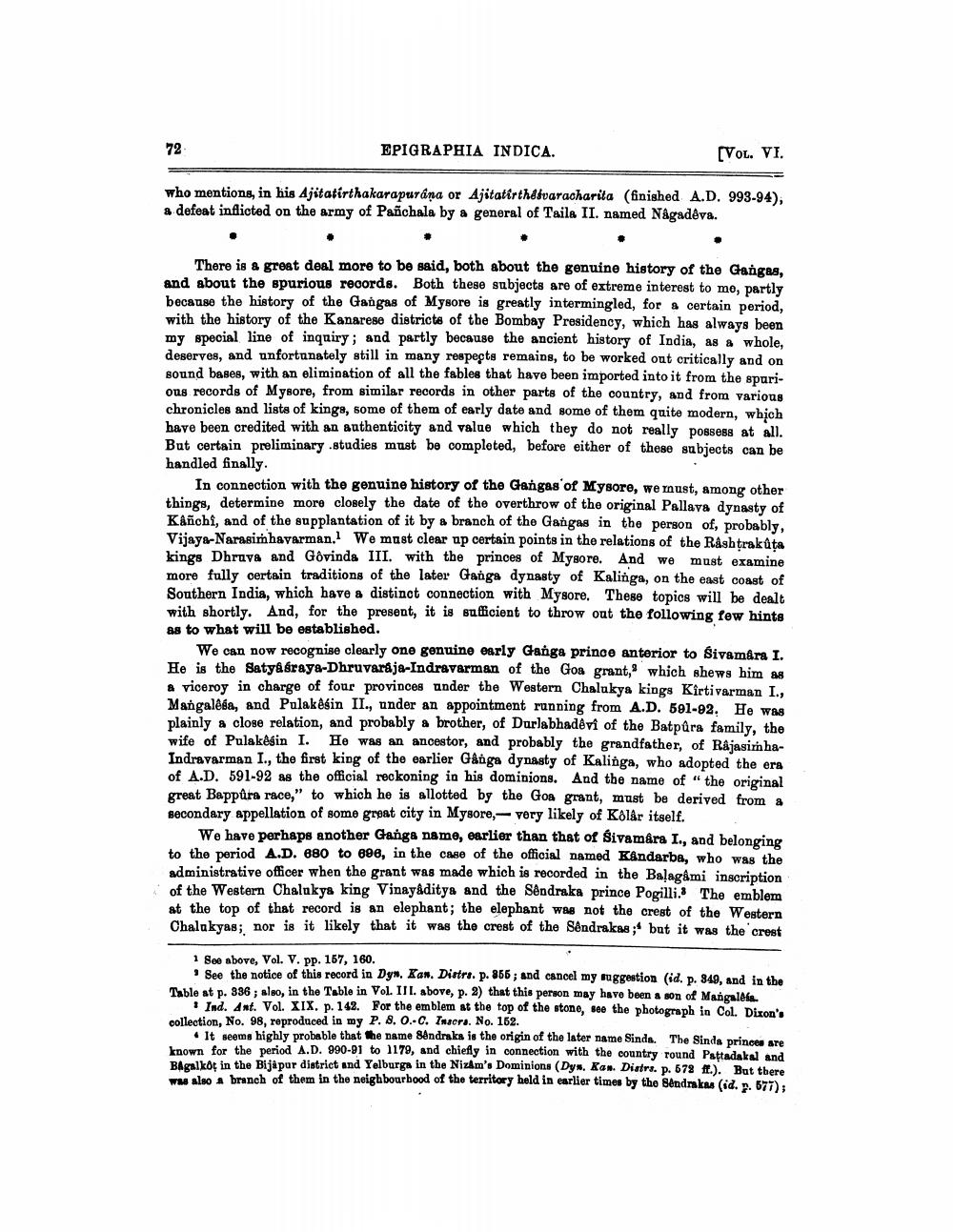________________
72
EPIGRAPHIA INDICA.
[VOL. VI.
who mentions, in his Ajitatirthakarapurana or Ajitatir théivaracharita (finished A.D. 993-94), a defeat inflicted on the army of Pañchala by a general of Taila II. named Någadeva.
There is a great deal more to be said, both about the genuine history of the Gangas, and about the spurious records. Both these subjects are of extreme interest to me, partly because the history of the Gangas of Mysore is greatly intermingled, for a certain period, with the history of the Kanarese districts of the Bombay Presidency, which has always been my special line of inquiry; and partly because the ancient history of India, as a whole, deserves, and unfortunately still in many respects remains, to be worked out critically and on sound bases, with an elimination of all the fables that have been imported into it from the spurious records of Mysore, from similar records in other parts of the country, and from various chronicles and lists of kings, some of them of early date and some of them quite modern, which have been credited with an authenticity and value which they do not really possess at all. But certain preliminary studies must be completed, before either of these subjects can be handled finally.
In connection with the genuine history of the Gangas of Mysore, we must, among other things, determine more closely the date of the overthrow of the original Pallava dynasty of Kanchi, and of the supplantation of it by a branch of the Gangas in the person of, probably, Vijaya-Narasimhavarman. We must clear up certain points in the relations of the Rashtrakuta kings Dhruva and Govinda III. with the princes of Mysore. And we must examine more fully certain traditions of the later Ganga dynasty of Kalinga, on the east coast of Southern India, which have a distinct connection with Mysore. These topics will be dealt with shortly. And, for the present, it is sufficient to throw out the following few hints
as to what will be established.
We can now recognise clearly one genuine early Ganga prince anterior to Sivamara I. He is the Satyasraya-Dhruvaraja-Indravarman of the Goa grant, which shews him as a viceroy in charge of four provinces under the Western Chalukya kings Kirti varman I., Mangalêéa, and Pulakêsin II., under an appointment running from A.D. 591-92. He was plainly a close relation, and probably a brother, of Durlabhadêvî of the Batpûra family, the wife of Pulakesin I. He was an ancestor, and probably the grandfather, of RâjasimhaIndravarman I., the first king of the earlier Gånga dynasty of Kalinga, who adopted the era of A.D. 591-92 as the official reckoning in his dominions. And the name of "the original great Bappûra race," to which he is allotted by the Goa grant, must be derived from a secondary appellation of some great city in Mysore,- very likely of Kôlår itself.
We have perhaps another Ganga name, earlier than that of Sivamara I., and belonging to the period A.D. 880 to 896, in the case of the official named Kandarba, who was the administrative officer when the grant was made which is recorded in the Balagami inscription of the Western Chalukya king Vinayâditya and the Sêndraka prince Pogilli. The emblem at the top of that record is an elephant; the elephant was not the crest of the Western Chalukyas; nor is it likely that it was the crest of the Sendrakas; but it was the crest
1 See above, Vol. V. pp. 157, 160.
See the notice of this record in Dyn. Kan. Distrs. p. 355; and cancel my suggestion (id. p. 349, and in the Table at p. 336; also, in the Table in Vol. III. above, p. 2) that this person may have been a son of Mangaleis.
Ind. Ant. Vol. XIX. p. 142. For the emblem at the top of the stone, see the photograph in Col. Dixon's collection, No. 98, reproduced in my P. 8. O.-C. Insors. No. 152.
It seems highly probable that the name Sendraka is the origin of the later name Sinda. The Sinda princes are known for the period A.D. 990-91 to 1179, and chiefly in connection with the country round Pattadakal and Bagalkot in the Bijapur district and Yelburga in the Nizam's Dominions (Dys. Kan. Distrs. p. 572 ff.). But there was also a branch of them in the neighbourhood of the territory held in earlier times by the Sendrakas (id. r. 577);




